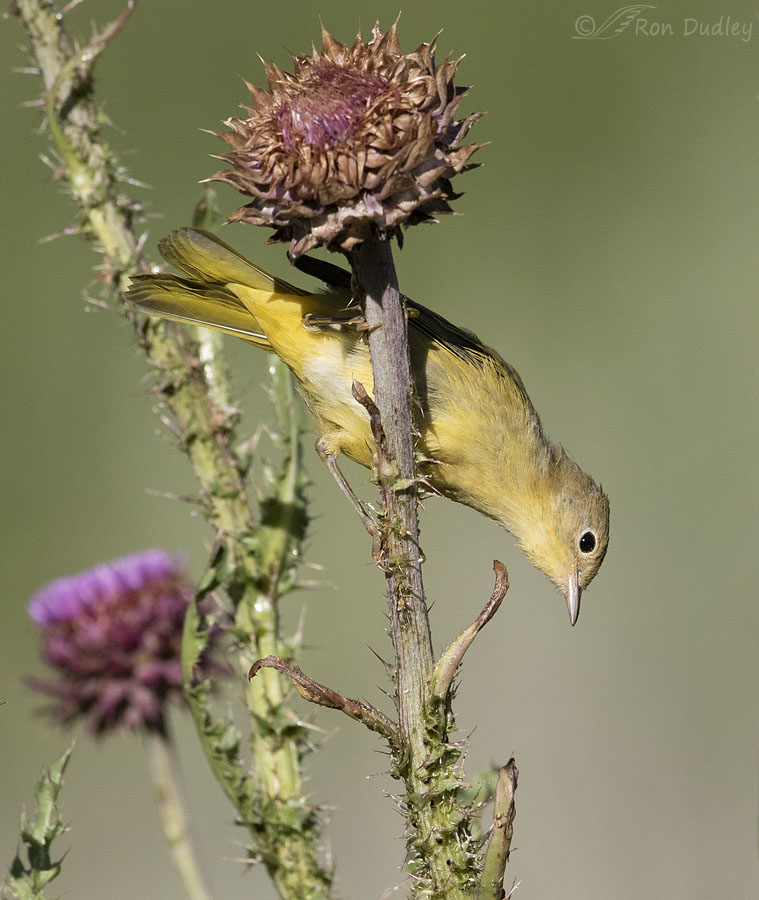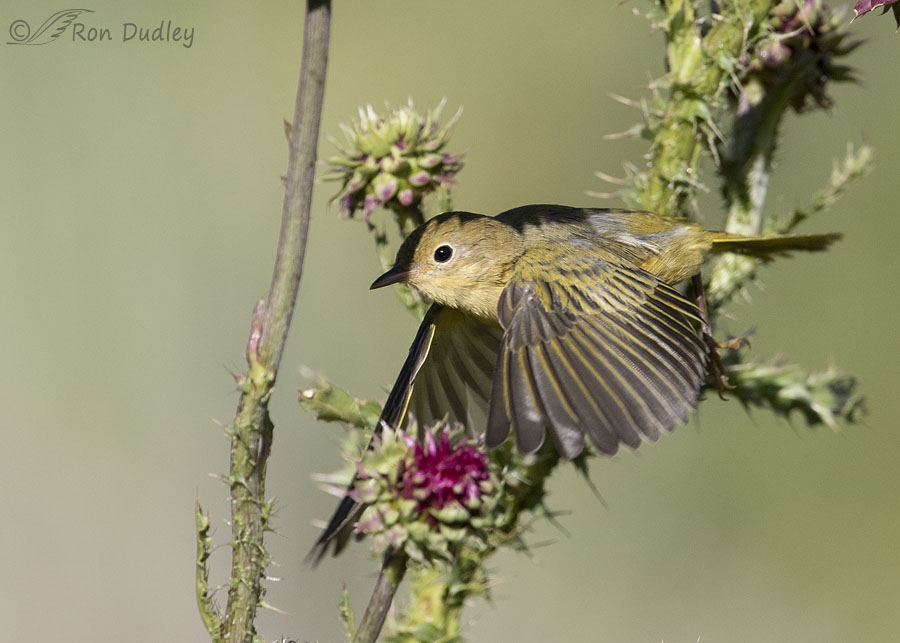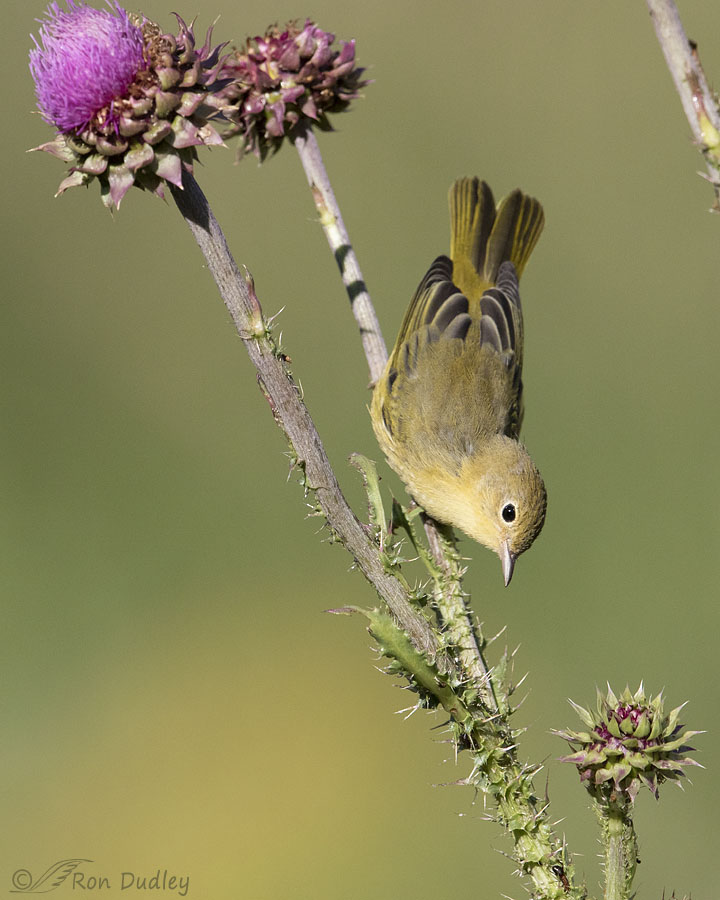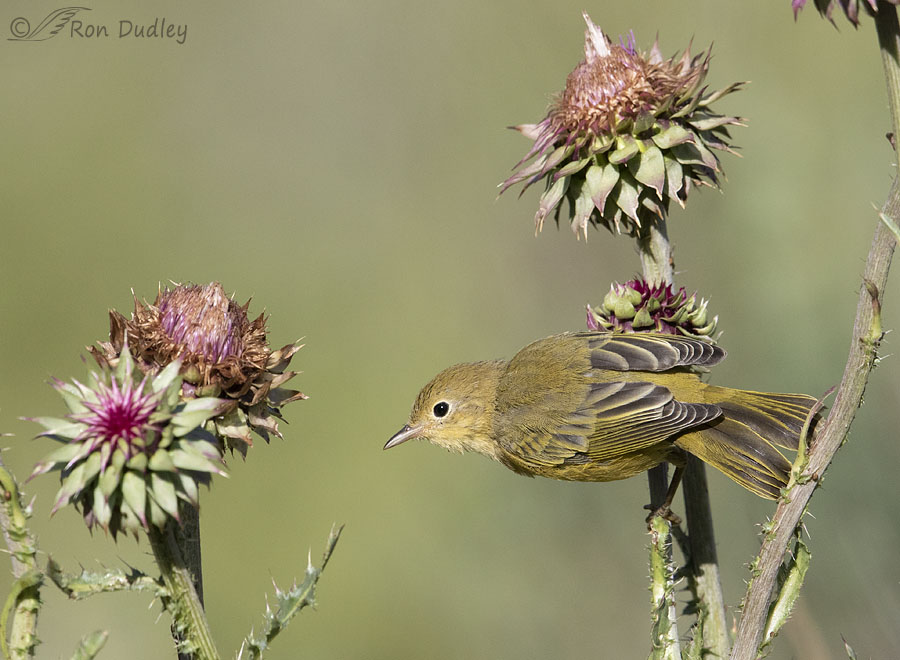Thistle, especially when flowering, can provide an attractive setting for bird photographs but it does have its challenges.
A little over two weeks ago I spent some time photographing Yellow Warblers in the Wasatch Mountains as they foraged for insects on thistles. It was a mixed group of adults and juveniles and I believe they were feeding mostly on aphids.
In addition to the expected difficulties of following hyperactive warblers with a long lens the thistles themselves presented their own challenges, especially compositionally. The flowers on the stalks were in various stages of development from immature flower buds to very attractive and colorful mature flowers to those far past their prime that can be less than appealing in a photo.
But no matter their stage of development they’re visually dominant on the photos, nearly as much so as the birds themselves, so cutting them off at the frame edge is often distracting and less than ideal. If you crop the photo to include the entire flower (if you have the entire flower in the original frame) the bird is often placed awkwardly in the composition.
It’s often a no-win situation but with these photos I did the best I could.

1/5000, f/7.1, ISO 800, Canon 7D Mark II, Canon EF 500mm f/4L IS II USM + EF 1.4 III Extender, not baited, set up or called in
These birds spent at least as much time upside down, or nearly so, as they did right side up. The tiny aphids they were after were mostly found in the protected spaces between the sharp spines of the thistle so it took some acrobatic maneuvering to get at them safely.
The spines point upward so it’s often safest to go after the aphids between them from above.

1/4000, f/7.1, ISO 800, Canon 7D Mark II, Canon EF 500mm f/4L IS II USM + EF 1.4 III Extender, not baited, set up or called in
Warbler flight shots are incredibly difficult to get, in part because of their unbelievable quickness at takeoff, but I try anyway. This photo has at least three strikes against it including the out of focus flower between the bird’s wings, the vertical stem directly in front of its bill and the shadow on the front part of its face. That shadow aggravates me most of all.
But it’s a warbler in full flight and the bird is sharp so for me it’s a keeper.

1/4000, f/7.1, ISO 800, Canon 7D Mark II, Canon EF 500mm f/4L IS II USM + EF 1.4 III Extender, not baited, set up or called in
While I was taking this shot in the field I remember trying to include the flowers at upper left and lower right in the frame and at the same time keep my active focus point on the bird’s face. I mostly succeeded but I just didn’t have quite enough room for the flowers up top, they’re too close to the frame edge.
But I still like the shot, mostly.

1/4000, f/7.1, ISO 800, Canon 7D Mark II, Canon EF 500mm f/4L IS II USM + EF 1.4 III Extender, not baited, set up or called in
Here I thought the warbler was going to jump to the flowers at left and my goal was to catch him in mid-jump but it didn’t happen.
But compositionally I like this photo as well as any I took of the warblers that morning. I didn’t cut off any of the primary flowers, the bird is well placed in the frame, all the elements in the photo are sharp or sharp enough and I have a clean background.
Anyway, good or bad that’s how my session with these warblers turned out. I love photographing birds on thistles and I should have many opportunities with various species on thistles in the coming weeks.
But it does have its challenges.
Ron


Wonderful colors and light too.
You did very well – a wonderful series
Thank you, Gary.
Simultaneously realistic and artistic, as so many of your images are.
The Yellow Warblers seem to effortlessly navigate amongst the spines of the thistles; a skill I, for one, haven’t mastered.
Nor have I, Lyle. The spines of prickly pear have been especially unpleasant for me but I have the same problem with thistles.
Am so happy that I am not a photographer and as a result smile with joy and delight at each and every one of your photographs. Would never have noticed the shadow on the warbler’s face in the 2nd shot because I am awed by the wings. Ignorance is bliss LOL.
“Ignorance is bliss LOL.”
Sometimes it can be, Kathleen.
I prefer the vertical composition the best. The angled thistle stem and the bird facing in the opposite direction of the dying bloom. Very contrary – very left-handed.
I’m good at contrary, Kathleen. My mom repeatedly told me I was contrary starting when I was very young. 🙂
Captain Picky rides again. I do understand the urge and can even sometimes see the miniscule nit you are picking at, but I am endlessly grateful for the images you share.
This morning is no exception.
“Captain Picky rides again”
Thanks for the smile, EC. A new moniker for me…
Well, I get that you don’t like the shadow (among other things) in #2, but I do love the look of those fanned wings, capturing a view one would normally not see because it happens so fast. Hard not to like these images of such beautiful little rays of sunshine, no matter what nits the photographer may discern! 🌞
“I do love the look of those fanned wings, capturing a view one would normally not see because it happens so fast”
That’s how I feel too, Chris. It happens far too fast for it to register with our brains, even if our eyes do ‘see’ it.
I’m especially drawn in by shots 1 and 3. I think it’s the vertical crop and the way the angle of the warbler complements the angles of the stems. I really like 1 because I see a story between the two thistles — young and old in concert. To me, the warbler looks a little disheveled, so I’ve made the story that it’s getting aphids to feed youngsters; thus, the middle of life.
Your interpretation works for me, Marty.
Wonderful series Ron! Thanks for sharing!
Thanks, Charlotte.
Oddly, I almost never see your nits until you pick them out! I’m always focused on the bird and these little guys/gals are spectacular (as always)!
I love the color play between the violets and greens of the thistles and the yellow greens of the warbler(s). And oh the feather detail. How do they DO that?
Again, just WOW! Oh yeah, I’ve already stipulated that 😉
Thanks, Laura. You can count on me to point out those nits for you… 🙂
A “challenge” for sure! 😉 Mostly met……. 🙂 Interesting on the thorns pointing up – guess I’ve never “checked that out”…..only know they are nasty….. 😉 Canada and Bull Thistles blooming here and notice fewer gold finches at the feeder. Seem to have a lot of Yellow Warblers this year and FINALLY have a kingfisher screaming through the yard……. 🙂
Judy, I haven’t seen ‘my’ kingfishers for about 2 weeks. I suspect now that the juvies are older they won’t be hanging around that pond any more.
Very nice Ron!
Thanks, Jean.
That last one really does have good composition. To my eye it looks perfectly balanced. It certainly does look like the Warbler is going to jump over. I like thistles and other plant life where birds are eating aphids or insects because they tend to stay for a significant number of shots instead of flying off as so often happens on other perches. Very nice series.
Thank you, Everett.
What a nice group! i see all the little problems you mention but they are all lovely to look at and the light strikes me as particularly beautiful. The second from the last photo is gorgeous, though I can see what you mean about the tightness on the upper left. Some folks wouldn’t hesitate to add a little extra canvas there …
That’s one thing I can’t complain about, Joanne. I had very good light that morning.
These are some great shots! Envy, envy!!
Stay safe!
Thank you, Dick.
Like all of these but especially the last! 😍 The flower heads, new and old really accent the warbler nicely and everything meshes so well with colors. What type of thistle are these…they definitely are different from the few varieties we have. I do like its look…those flower heads are attractive. Our GoldFinches are on the thistles now all the time, food and for nesting so driving through pasture areas is a joy! Also the thistles attract all sorts of butterflies and there seems to be an abundance of the clearwing moths this year! Love this month!
Kathy, I believe they’re musk thistles. Some of our thistles are native but many are not. I like photographing birds on nearly all of them.
Yes, musk thistle (Carduus nutans). One of the more beautiful invasive thistles, with the notoriety of being on the Utah Noxious Weed List.